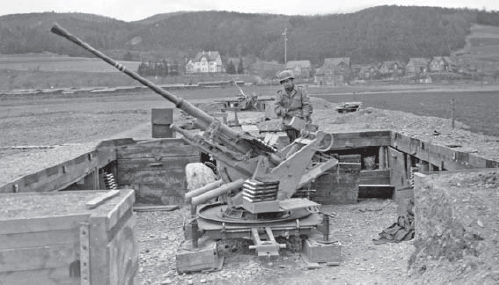
Until the mid-1930s, the Flak force had been controlled by the army (Heer) and was primarily oriented towards the tactical defense of the field army. When Hitler renounced the Versailles treaty and created the independent Luftwaffe in March 1935, its new commander, Hermann Göring, took steps to absorb the Flak force into the new Luftwaffe. This was the first step in a process that would eventually see the Luftwaffe assume the primary responsibility for air defense of the Third Reich.
As part of this process, the Luftwaffe embarked on a major rearmament effort that included the acquisition of about 1,900 88mm heavy Flak guns, along with associated gun directors, sound detectors and searchlights. The 88mm heavy Flak gun became the basis for national air defense, supplemented by 20mm and 37mm light Flak guns for low-altitude defense. The air campaigns of the Spanish Civil War in 1936–39 were intensely studied for lessons regarding the air defense of cities and the value of Flak in modern warfare.
The first major investment in fixed Flak positions for national air defense was part of the larger Westwall fortification effort. By the late 1930s, the principal bomber threat was the French Armée de l’Air, and the Westwall program included the Air Defense Zone-West (LVZ-West, or Luftverteidigungszone West). This created a Flak belt stretching from the Eifel region, south through the Saar along the Mosel River, and on to the Black Forest and Swiss frontier. The LVZ-West was not intended to present an impenetrable wall, but rather to act as an initial barrier to French or British bomber attack that would identify the direction of the attack and disrupt it before it could reach its intended target zones deeper in Germany. The initial line consisted of light Flak batteries armed with 20mm and 37mm guns, followed by a second line armed with heavy 88mm guns. Serious construction began in 1938 and was supervised by a special staff of Flak-Regiment 29 in Frankfurt-am-Rhein. In total, 2,056 bunkers were built for LVZ-West from Düren to Karlsruhe through the summer of 1940 at 48 light Flak and 197 heavy Flak sites capable of accommodating 576 light Flak guns and 788 88mm Flak guns. The LVZ-West contained about a third of the heavy Flak batteries available at the start of the war.
The LVZ-West construction was based on seven standard designs. These included command posts (F-Stand, or Führerstand, G-Stand, or Gefechtsstand), ammunition bunkers (M-Stand, or Munitionsraum), and personnel shelters (U-Raum, or Doppelgruppenunterstand); V-Stand (Gruppenunterstand am Voderhang), as well as defensive types such as small machine-gun posts. As will be noted, none of the standardized bunkers were designed to accommodate the Flak guns. Instead, the guns were deployed in less expensive earthen fieldworks. The presumption was that the Flak sites were not likely to be primary targets, and that personnel and ammunition were more vulnerable than the guns. Luftwaffe tactical doctrine recognized that there would never be enough Flak guns to cover every possible objective, and so the 88mm heavy Flak gun was designed to be mobile; batteries could be shifted to respond to the objectives of enemy bombing campaigns.

One of the standard configurations for Flak emplacements was the use of a parapet around the G-Stand with outer walls of planks and the space between filled with earth. The ammunition lockers for this 37mm Flak gun were located around the periphery of the gun pit, while one of the lockers was set aside for equipment associated with the gun. This particular emplacement of the 4. Flak-Division was captured by the US 7th Armored Division on the Edersee in the Hesse region in late March 1945. (NARA)
The LVZ-West was the first attempt to create an integrated air defense system incorporating sensors such as searchlights and sound detectors, a common air reporting system, as well as Flak guns and fighter bases. Although the 1937 Luftwaffe armament program included funding for air defense radar, this new technology did not play a major role in the LVZ-West.
At the beginning of the war, the Luftwaffe Flak force was the most lavishly equipped in the world. There were 2,628 heavy Flak guns (88mm and 105mm) compared to about 1,300 heavy anti-aircraft guns in Britain. Although the Luftwaffe was responsible for both strategic air defense of the Reich and tactical air defense of the army, in 1939 about 80 percent of its resources were devoted to homeland defense. The one area where Britain had a significant lead was in its integrated air defense system which included the Chain Home radars and a sophisticated network of forward observers and air reporting centres which collated the data and passed it on to both the fighter and AA gun force. Germany had begun to take steps in this direction, but it had not integrated early warning radars into its network as extensively as in Britain. In late 1939, the Luftwaffe had only eight Freya early warning radars on the German Bight, the small stretch of coastline along the North Sea between the Netherlands and Denmark that was especially vulnerable to British bomber attack.
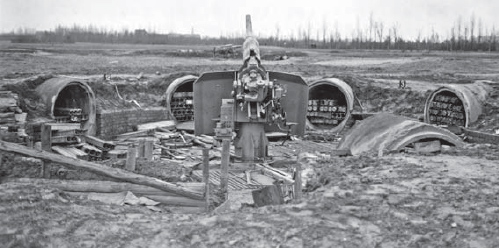
When Flak batteries were re-positioned in 1944, they often ended up in improvised emplacements. This is a reinforced G-Stand for a 88mm heavy Flak gun of the 7. Flak-Division stationed near Neuss and captured by the Ninth US Army in March 1945 during the fighting along the Rhine. The emplacement has brick walls, and the ammunition lockers are of improvised construction using sections of concrete drainage pipe. The gun is typical of wartime static Flak units, with a simple Sockellafette mount. (NARA)
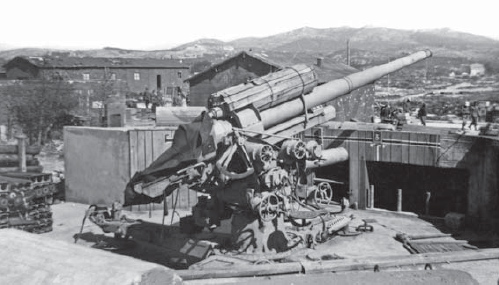
An 88mm heavy Flak gun in an enhanced G-Stand with the outer walls made of poured-concrete. This gun is an early example that is still mounted on the mobile cruciform base; most Flak emplacements deployed after 1941 used a simple Sockellafette pedestal mount. (NARA)
With the start of the war in September 1939, German cities were subjected to air defense decrees such as mandatory night-time black outs. The RAF launched its first bomber attack against the Wilhelmshaven naval base on September 4, 1940. Britain and France refrained from bomber attacks on German cities during the Phoney War from September 1939 to May 1940. The French Armée de l’Air conducted nearly a thousand night missions into Germany during the Phoney War, but they were primarily reconnaissance and leaflet missions. Likewise, RAF bombers were confined to leaflet raids and a limited number of attacks on German military targets, especially shipping. British anti-shipping raids in December 1939 were hotly received and Flak along the coast proved so effective that instructions were issued to avoid low-level attacks and conduct missions from 13,000 feet. Some Allied air attacks during the Battle of France in May–June 1940 struck German cities along the border, but were aimed at military objectives. Although Germany bombed cities such as Warsaw in 1939 and Rotterdam in 1940, the Luftwaffe refrained from attacks on major French and British cities due to the concern that it would unleash an unrestrained bomber campaign.
In the event, an inadvertent German raid on London during the initial phase of the Battle of Britain in August 1940 prompted Churchill to authorize retaliatory strikes against Berlin. Berlin was first hit on the night of August 25–26, 1940 and Hitler then unleashed an intensified campaign against British cities. The restraint shown in the first year of the war evaporated, and German cities quickly became a target of the RAF. The first few raids on Berlin in August 1940 were small scale and mainly hit the city’s outskirts. Their psychological and political consequences, however, were far greater.
| Luftwaffe Flak batteries in Germany | |||
| Heavy gun | Light gun | Searchlight | |
| Jan. 1941 | 537 | 395 | 138 |
| Jan. 1942 | 744 | 438 | 174 |
| Jan. 1943 | 628 | 535 | 277 |
| Dec. 1943 | 1,300 | 708 | 395 |
| Feb. 1944 | 1,508 | 623 | 375 |
| Aug. 1944 | 2,655 | 1,602 | 470 |
Göring had boasted that Berlin would never be bombed, but it became blatantly clear that Berlin was no longer inviolate. The persistence of the British raids into September 1940 forced the Nazi Party to react. On September 9, 1940, Hitler ordered the construction of six Flak tower complexes in Berlin. The Berlin Flak towers were emblematic of Hitler’s architectural enthusiasms, and were the most massive fortified structures yet undertaken by Nazi Germany. The designs were in the neo-Romantic style favoured by Hitler, with an attempt to incorporate details of medieval fortresses. The location of the massive Flak positions in central Berlin were intended to reassure German civilians of the impregnable defenses of the Reich. Details of these structures are covered later in the section on air-raid bunkers.
The increasing threat of RAF bomber attack in 1940–42 accelerated the growth of heavy Flak in the homeland defense role. In September 1939, Luftwaffe Flak deployed 2,628 heavy Flak guns in the 88mm–105mm range, and by February 1944 this grew more than five-fold to 13,500 heavy guns. In general, more than half of the heavy Flak guns were located in Germany for air defense of the Reich, with the remainder being deployed in other theatres for both tactical defense of the field armies as well as regional defense of key installations. The Flak batteries based in Germany were often dubbed Heimatflak (Homeland Flak).
The early air battles over the Reich in 1940–41 were a struggle of the blind against the blind. Early RAF attempts to conduct daylight bombing raids into Germany were savaged by the Luftwaffe fighter force, and the RAF switched to night-bombing. The early campaigns in 1941 were directed against industry and transportation targets, but the lack of night navigation and bombing aids resulted in such poor accuracy that the attacks were often worthless. The German Flak force had been developed primarily to deal with the threat posed by daylight attacks, and relied on an elementary air alert system. Visual observers were stationed at Fluwa (Flugwach) posts and telephoned their reports to an area Fluko (Flugwachekommando, or air reporting centre). This data was used to alert neighbouring Flak units. Long-range early warning was conducted by the handful of Freya early warning radars along the German Bight and a network of outmoded sound detectors.
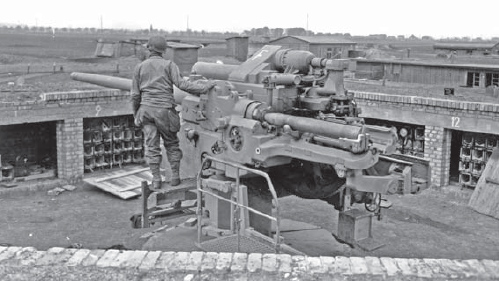
The 128mm Flak 40 was the best heavy Flak gun in German service during the war and began to enter service in 1942. It was not especially numerous, with only 570 in service by 1945. This shows a typical enhanced G-Stand using brick construction for the walls of the gun pit. The ammunition lockers in the wall are numbered, which was standard Luftwaffe practice. This particular gun belonged to the 14. Flak-Division defending the Leuna refinery. This division claimed the destruction of 147 American tanks during the fighting in this sector in April 1945, mainly against the US 2nd Armored Division. (NARA)
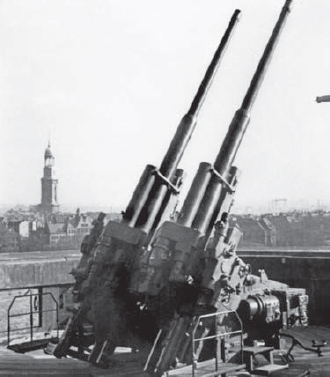
The 128mm anti-aircraft was also built in a twin mount, but only 33 were deployed by 1945 as the 128mm Flakzwilling 40. They were used principally on the Flak towers in Berlin, Hamburg and Vienna as this example is seen here on Gefechtstürm IV in the Heiligengeistfeld area of Hamburg with the spire of St Michael’s church evident in the background. (NARA)
This early warning network expanded in 1940–41 as more radars were manufactured, and was gradually extended along the coastline of occupied Europe, especially in France, Belgium, the Netherlands, and Denmark. For night combat, Flak units within Germany originally relied on sound-detectors (RHH, or Ringtrichter-Richtungshörer) to aim their searchlights, but the inherent inaccuracies of such a system, along with the difficulties of using optical gun directors at night resulted in abysmal accuracy. Indeed, the poor accuracy of the heavy guns at night forced the use of crude tactics such as barrage fire. This was both wasteful of expensive ammunition, and ineffective. The Luftwaffe was also slow to embrace radar-equipped night-fighters, in no small measure due to the unsophisticated notions of senior leadership such as Göring and Ernst Udet, the head of the Luftwaffe technical office. Udet once complained that radar “took the fun out of flying.”
A vital first step in improving the night-fighter force was taken in the summer of 1940 when the scattered units were consolidated into NJG 1 (Nachtjagdgeschwader, “night-fighter wing”) under Oberst Josef Kammhuber. This talented young officer saw his responsibilities greatly expand through 1941 as it became apparent that Germany required an integrated air defense network comparable to that in Britain. The shortcomings in German aircraft-mounted night-fighter radars forced Kammhuber to shift his attention to ground-based means, first by deploying a Scheinwerfer-Riegel (“searchlight belt”) along the German frontier, alerted and directed by Freya early warning radars and sound-detector. The belt consisted of a line of rectangles 45km (2 miles) wide and 22km (14 miles) deep, codenamed Himmelbett (“four-poster bed”), each with their own control post. The Himmelbett system was based initially on Henaja tactics (Helle Nachtjagd, “illuminated night-fighting”) which used the radars and sound detectors to locate an approaching RAF bomber and direct a master searchlight against it, followed by nearby searchlights. The night-fighters assigned to each Himmelbett sector could then attack the intruding bombers using the searchlight illumination. The RAF dubbed this belt the “Kammhuber Line” after its commander. By the late summer of 1941, there were enough of the new Würzburg radars available so that much more sophisticated Dunaja tactics (Dunkle Nachtjad, “dark night fighting”) could be used in the Himmelbett sectors. Each Himmelbett sector contained a Freya early warning radar and two of the more precise Würzburg radars. The Freya would detect the approach of British bombers, one Würzburg would track the bombers, while the second Würzburg would track the German night-fighters. Data from the radars went to a Himmelbett night-fighter control station that passed the data to the night-fighters. The searchlights were moved back further east, so that if the radar direction failed to conclude the interception, the searchlight belt and Flak guns behind the radar line could have another try.
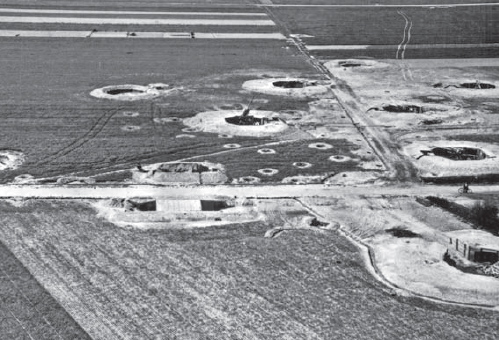
A variety of battery sizes were used during the war, including an enlarged 12-gun battery like the 105mm battery seen here. The basic six-gun battery is in the centre of the position, with a second circle of gun-pits radiating further away from the centre. In this particular case, the outer row is lacking its guns. The covered pit in the left foreground is an entrenchment for a power generator trailer. (NARA)
This system was originally limited to the forward-deployed night-fighter units, but gradually a number of the most vulnerable German cities were covered using Konaja integrated air defense tactics (from Kombinierte Nachtjagd) which provided targeting data to both Flak and night-fighter units. These networks had central command posts codenamed Kiebitz (Kiel), Hummel (Hamburg), Roland (Bremen), Drössel (Ruhr region), Kolibri (Cologne), Dachs Nord (Frankfurt), Dachs Sud (Mannheim), Mücke (Munich) and Bärs (Berlin). This marked the start of the introduction of radars into the Flak force.
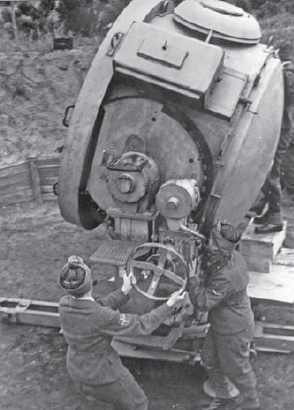
An essential ingredient of the Reich Flak defenses were the Scheinwerfer Regimenten, equipped with a variety of searchlights. This is a 150cm Flakscheinwerfer 34 operated by a women’s Flakhelferinnen unit in June 1944. The Luftwaffe Flak units suffered from extensive redeployment of their original complement of young men who were siphoned off for combat assignments outside Germany and replaced by women, teenage boys, and overage workers from nearby factories by 1944. (Library of Congress)
The Kammhuber Line underwent continual amplification and improvements through 1943. In the spring of 1942, the new Würzburg-Riese (“giant Wurzburg”) was introduced which offered significantly improved range. New long-range early warning radars including a Freya-derivative, the Mammut (“mammoth”), were deployed along the Channel coast to identify the RAF bombers at the earliest possible opportunity and alert the Himmelbett stations. The story of the development of German air defense radar is far too complicated to be detailed here, but it had an immediate impact on air defense fortification efforts. To begin with, the creation of the Kammhuber Line initiated an extensive construction program in France, Belgium, the Netherlands, and Denmark. This consisted of numerous radar sites, control posts, and the Himmelbett command posts. In the case of the forward-deployed radars along the coast, the radar posts became enveloped in the Atlantikwall fortification effort that was gathering steam by 1942. Instead of simple tactical emplacements, the radars were erected in fully protected bunker complexes consisting of a fortified radar post along with associated shelters for the crews. The construction of these Luftwaffe sites consumed about 10 percent of the material used in the construction of the Atlantikwall in 1943–44.1
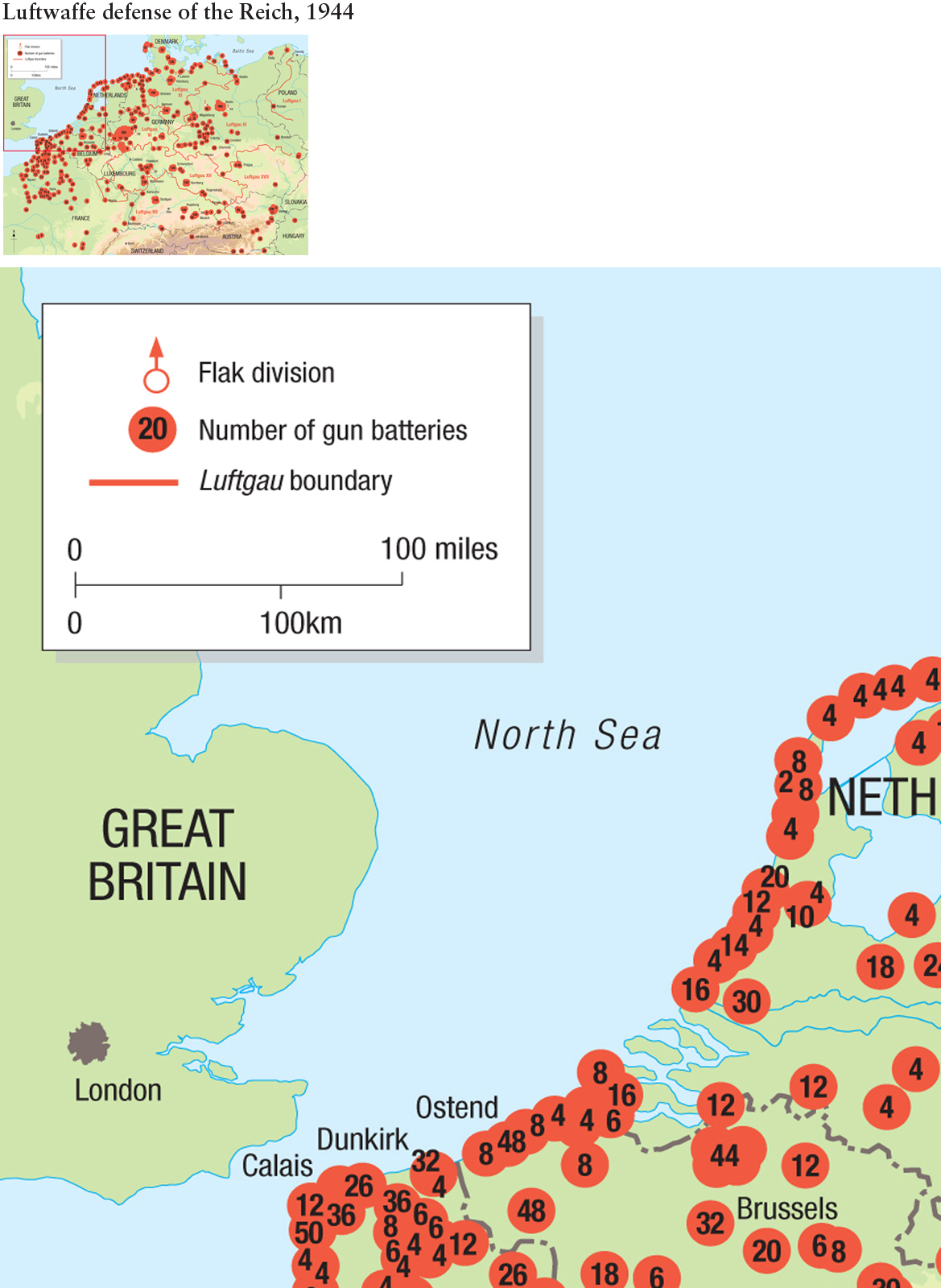
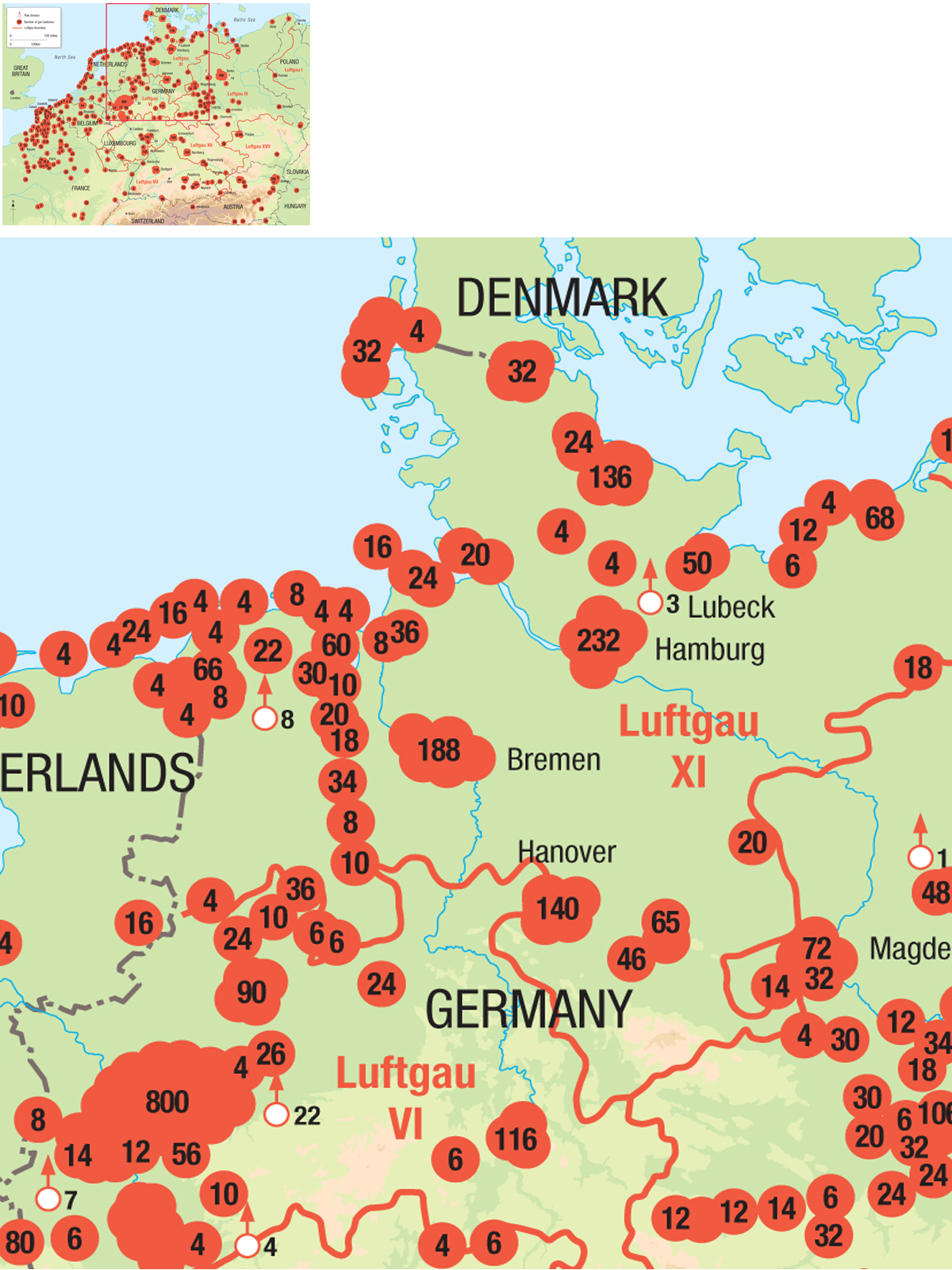
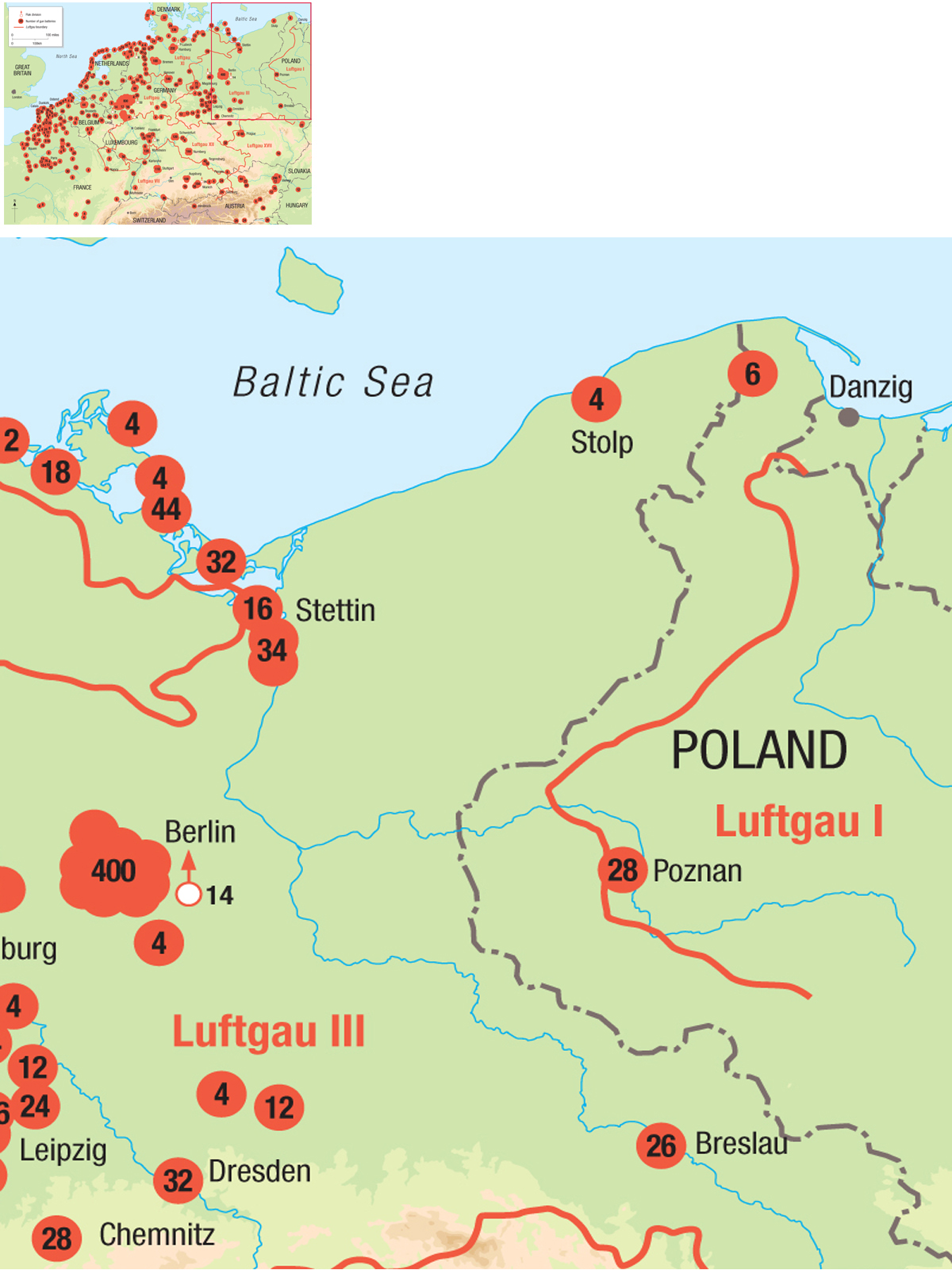
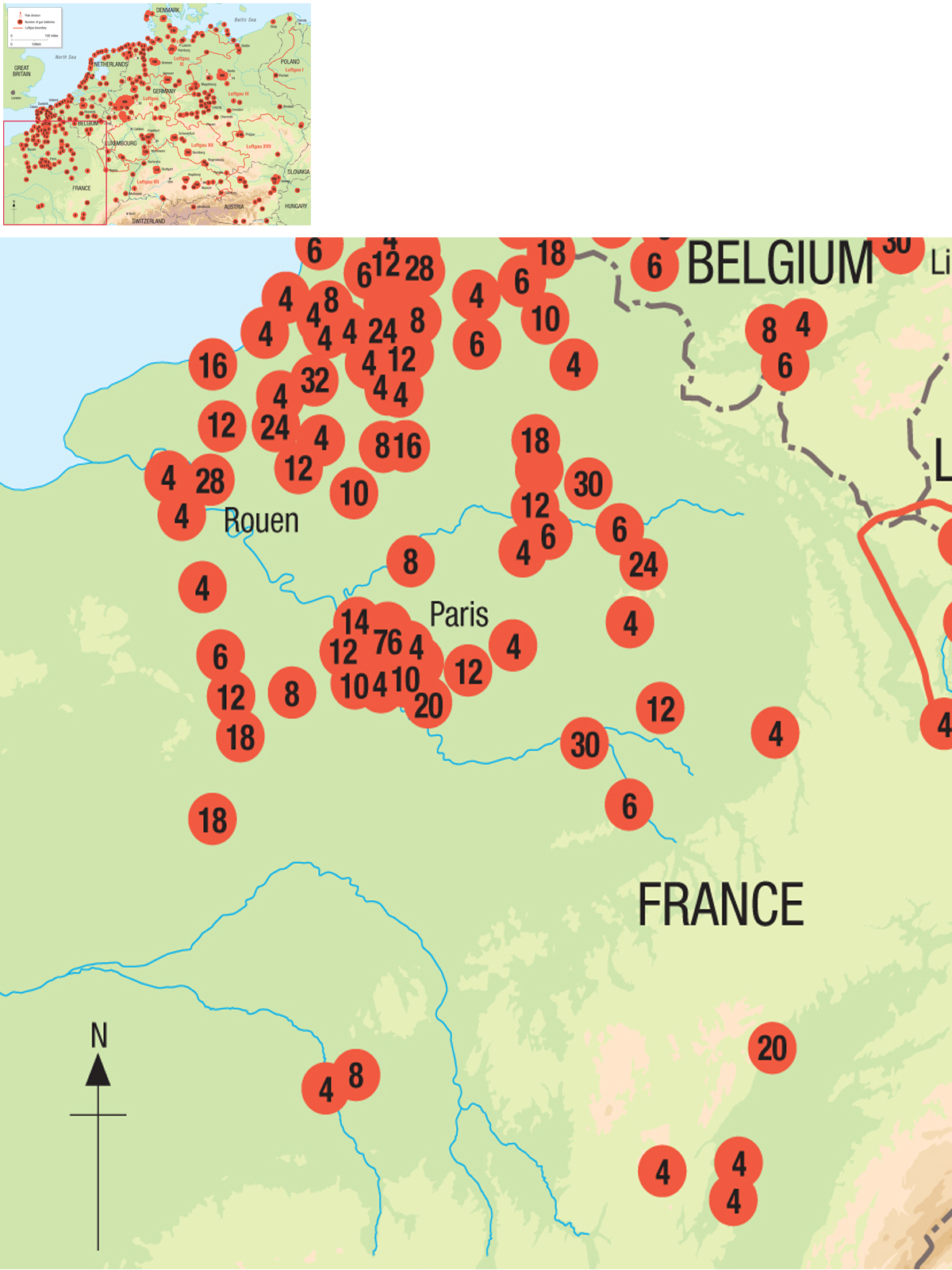
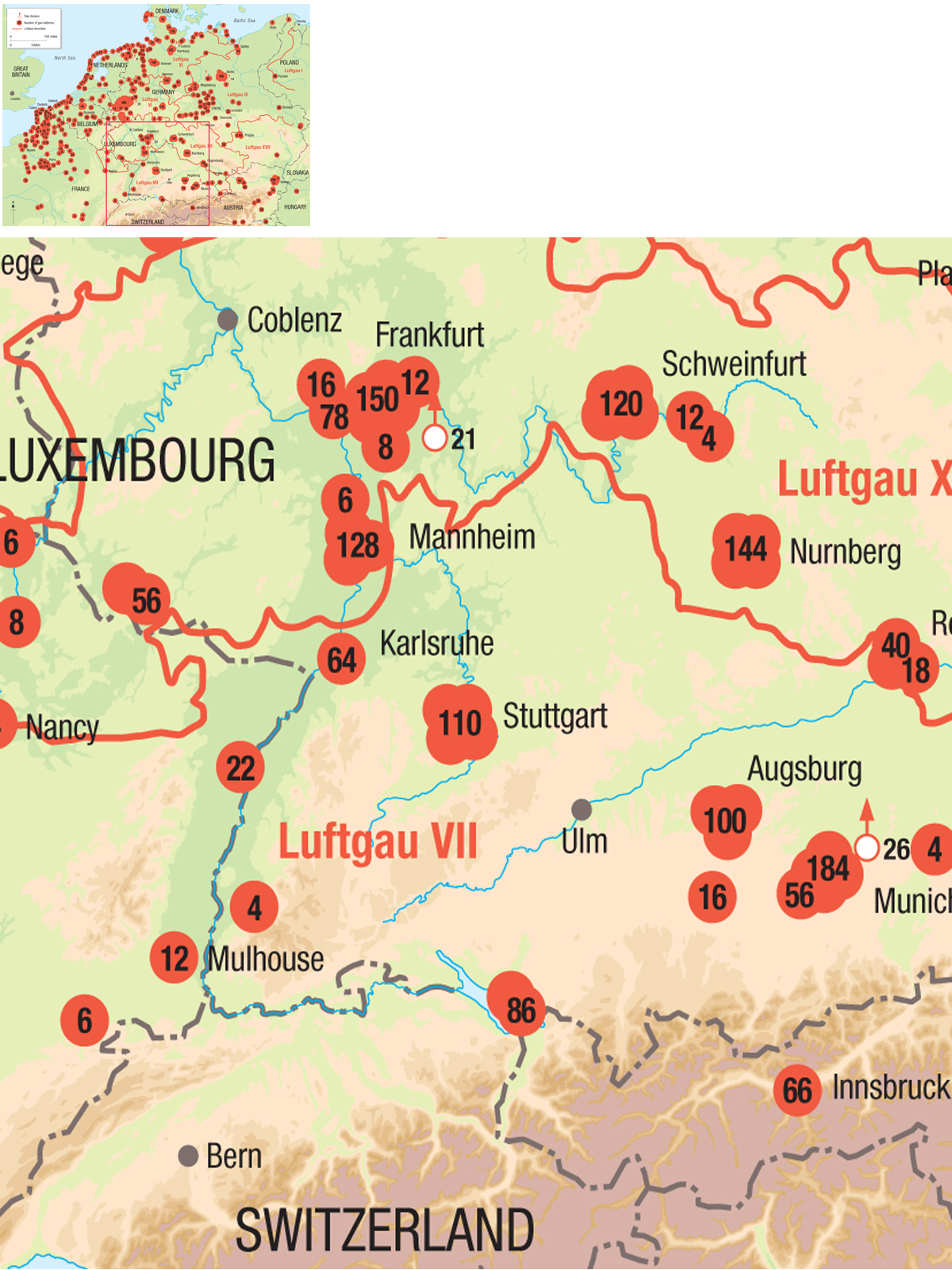
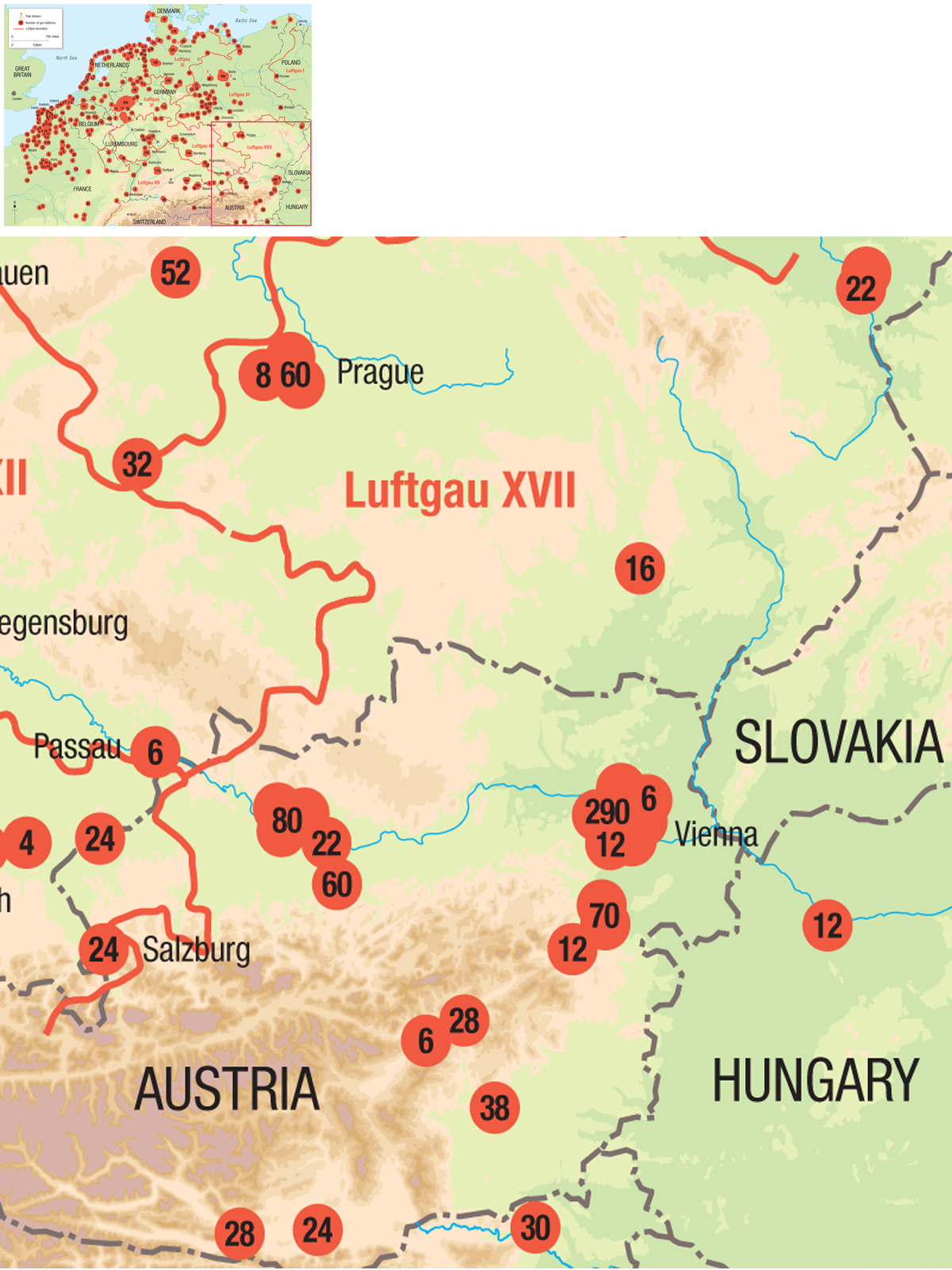
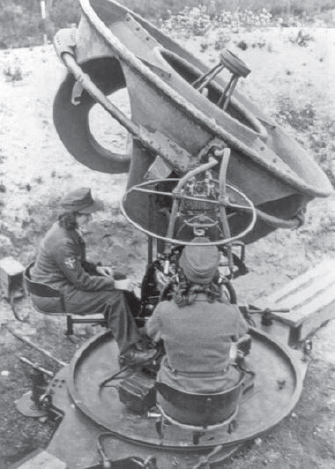
RRH (Ringtrichter-Richtungshörer) sound detectors were the standard method of aiming searchlights in the early-war years until the advent of fire-control radars. This RHH is crewed by Luftwaffe Flakhelferinnen, the women’s auxiliary service which took over an increasing part of the Flak arm’s signals and communication posts as a way to free up manpower for other combat arms. (Library of Congress)
Besides the radar sites themselves, a network of command sites was gradually erected as well. Each radar site had an associated command post (Flugmeldemess-Stellung), originally located in a simple wooden building called a “T-hut” due to its shape. Some radar sites, especially those along the Atlantikwall, altered from simple T-huts to standard L487 concrete bunkers in 1942–44. Radar sites would pass their information along to the regional command centre, originally known as the NaFü (Nachtjagdraumführer, “night-fighter director”). With the increasing tempo of US Army Air Force daylight bomber attacks in 1943, the early warning system switched from a night-time to an all-day system and the command centres were redesignated as JaFü (Jagdabschnittsführer, “fighter sector director”). These posts were generally located in extremely large, well-protected bunkers called Zentralgefechtsstanden (“central battle stations”).
As RAF bombing attacks against Germany increased in 1941–42, heavy Flak guns were deployed for Reich air defense outside Germany along the “Bomber Autobahn,” the main air routes between Britain and Germany over the Netherlands and Belgium. At its peak in 1943–44, about 70 percent of the Luftwaffe heavy Flak batteries were involved in air defense of the Reich, either in Germany itself, or in the western approaches in the Low Countries.
Although the Luftwaffe attempted to monopolize the control of large Flak units, the Kriegsmarine eventually created its own units, ostensibly limited to the protection of German ports. This force expanded greatly during the war, eventually numbering 88 Marine Flak-Abteilungen, each with four to six batteries. Many of the Flak batteries on the approaches to the Reich along the Dutch coast were Kriegsmarine batteries. Both the Heer (army) and Waffen-SS also organized Flak units during the war, but these were small tactical formations, usually organic to divisions and not used for homeland defense.
The Luftwaffe’s homeland air defense artillery force was organized in large formations, generally divisions and brigades, which were subordinate to the local Luftwaffe regional commands, the Luftgau. The Flak division was the basic tactical formation and was usually a regional organization with a flexible structure to manage all Flak sub-units within a given area. Typically, the division was broken into Flak groups (Gruppen), with the group’s headquarters assigned to defend a specific area. The group headquarters was comparable to a regimental headquarters in size. The group was in turn broken down into sector sub-groups (Untergruppen) with a headquarters roughly battalion-sized. A large city would typically have several groups; Munich for example, was defended by three heavy groups (Gruppen Nord-Ost, Nord-West and Sud) divided into five Untergruppen, a light sub-group with five Untergruppen, and elements of Scheinwerfer-Regiment 8, all subordinate to the 26. Flak-Division of Luftgau VII.
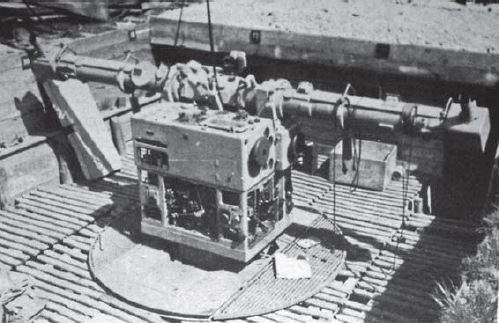
The brains of the Flak battery was its gun director which combined an optical range finder with a ballistic computer to provide the battery’s guns with precise firing solutions. The standard type during the war was the Kommandogerät 40, seen here in service with the 26. Flak-Division outside Munich. (MHI)
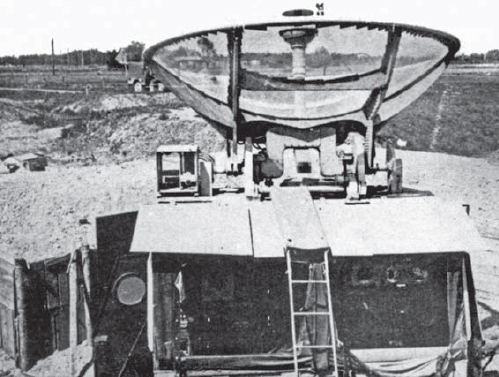
Through the course of the war, German Flak batteries came to depend on fire-control radars on a scale of two per battery. This is a Telefunken FuMG 41 T Mannheim radar, later called the FuMG 64 in use with the 26. Flak-Division near Munich in 1945. (MHI)
The basic combat formation for Flak was the gun battery (Batterie). At the start of the war, German heavy Flak batteries had four guns each. During the 1940–41 fighting, it became evident that the four-gun batteries were not sufficiently lethal against British bombers. As a first step, batteries were expanded to six guns, and this eventually became the common battery composition for most of the war. In the autumn of 1941, there were experiments with eight-gun double batteries (Doppelbatterien) and with 12-gun triple batteries (Dreifach-Batterien). These experiments were not entirely successful, and in particular the 12-gun battery was viewed as uneconomical due to its reliance on poor fire control data from a single command post.
Due to RAF reliance on night tactics in 1940–44, searchlights played a major role in German air defense. Searchlight regiments (Scheinwerfer-Regimenten) were generally under divisional control, and their subordinate battalions and batteries were scattered through the Flak division’s operating area, ideally on a scale of a battalion per Flak group and a battery per sub-group. Searchlights also played an important role in illuminating British night bombers for the German night-fighter force, and so they were often deployed independently of the Flak batteries for this mission, for example in the Scheinwerfer Riegel as mentioned earlier.
The principal innovation in Flak fire control in 1941 was the introduction of fire-control radars, first with the Würzburg and then with dedicated gun-control radars such as the Funkmessgerät. 39 (FuMG. 39) and the later FuMG. 41. By March 1942, about a third of the heavy Flak batteries had a radar. There were not enough radars to go around, so the practice began of concentrating the normal batteries into super-batteries (Grossbatterien) with the individual battery command posts consolidated into centralized operations centres (Auswertungen) to coordinate and concentrate their fire. The Grossbatterien were usually placed on the bomber approach routes and likely bombing lines, but outside the target area. The heavy gun batteries with the newer 105mm Flak guns were given priority for this configuration. In 1942, there were experiments with even larger batteries, nicknamed the “Mammoths” (Mammutenbatterien), which contained 36 guns.
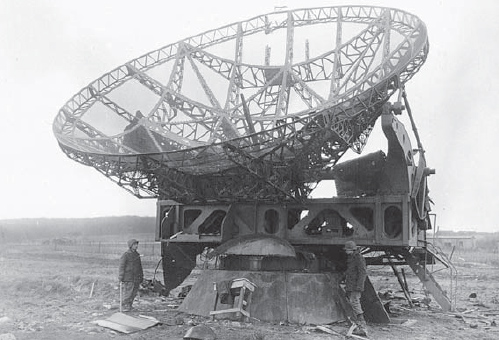
One of the most common air search radars in use to support the Flak force during 1942–45 was the FuMG 65 Würzburg-Riese, better known by the Allied intelligence designation “Wurzburg Giant”. This system weighed 11 metric tons and so was usually mounted in a static position. This particular radar from the 4. Flak-Division was located near Bad Godesburg in 1945. (NARA)
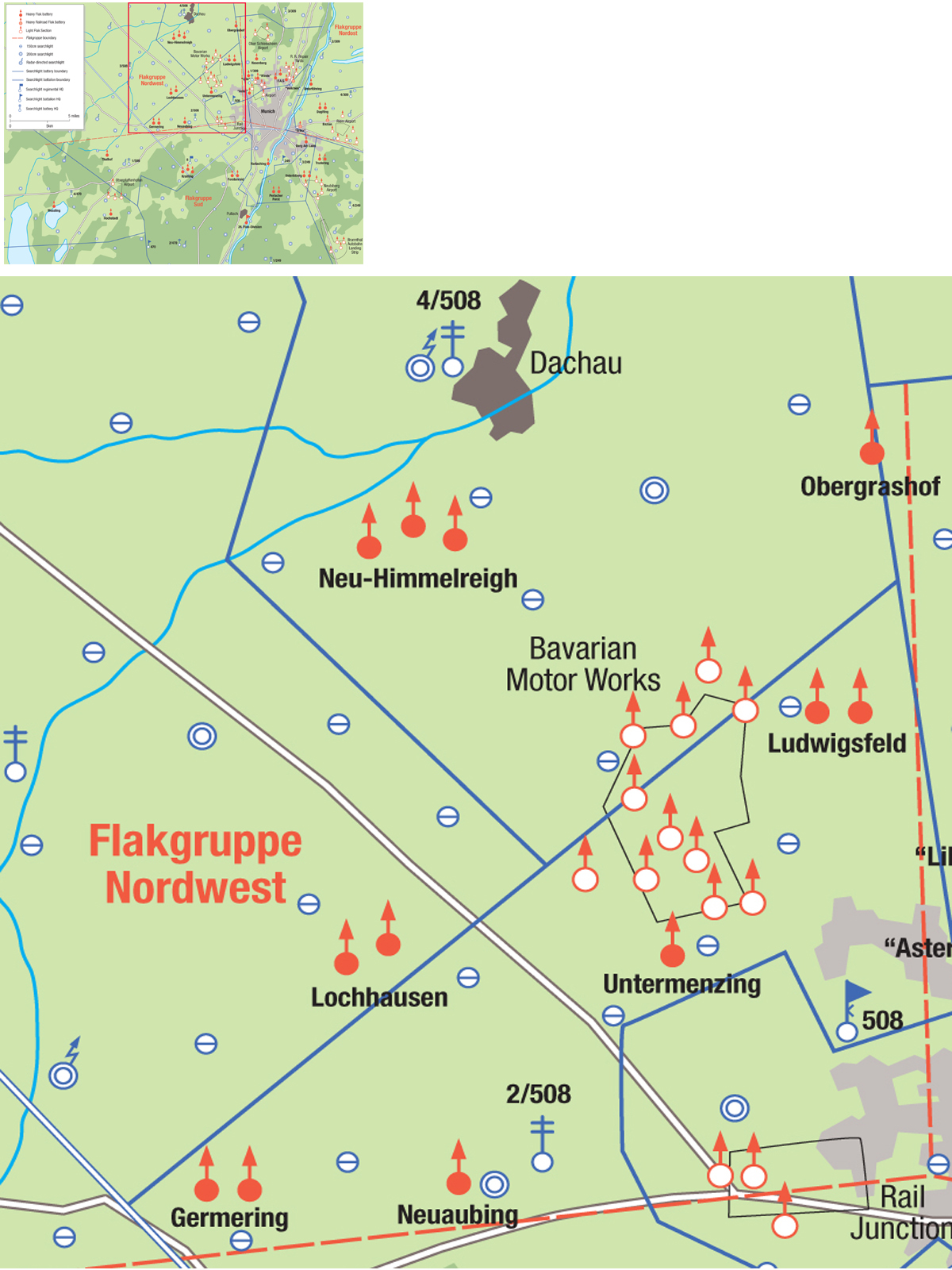
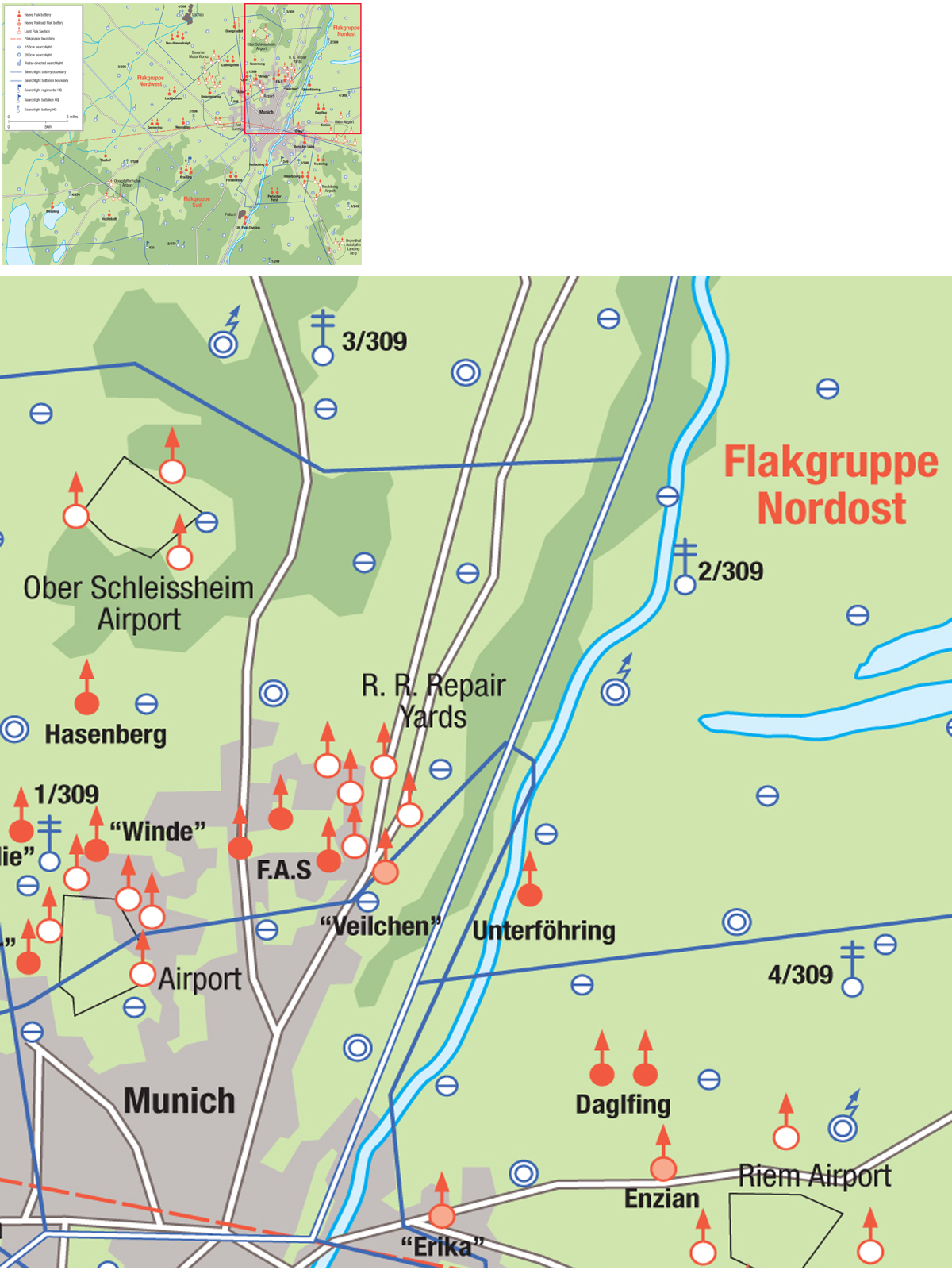
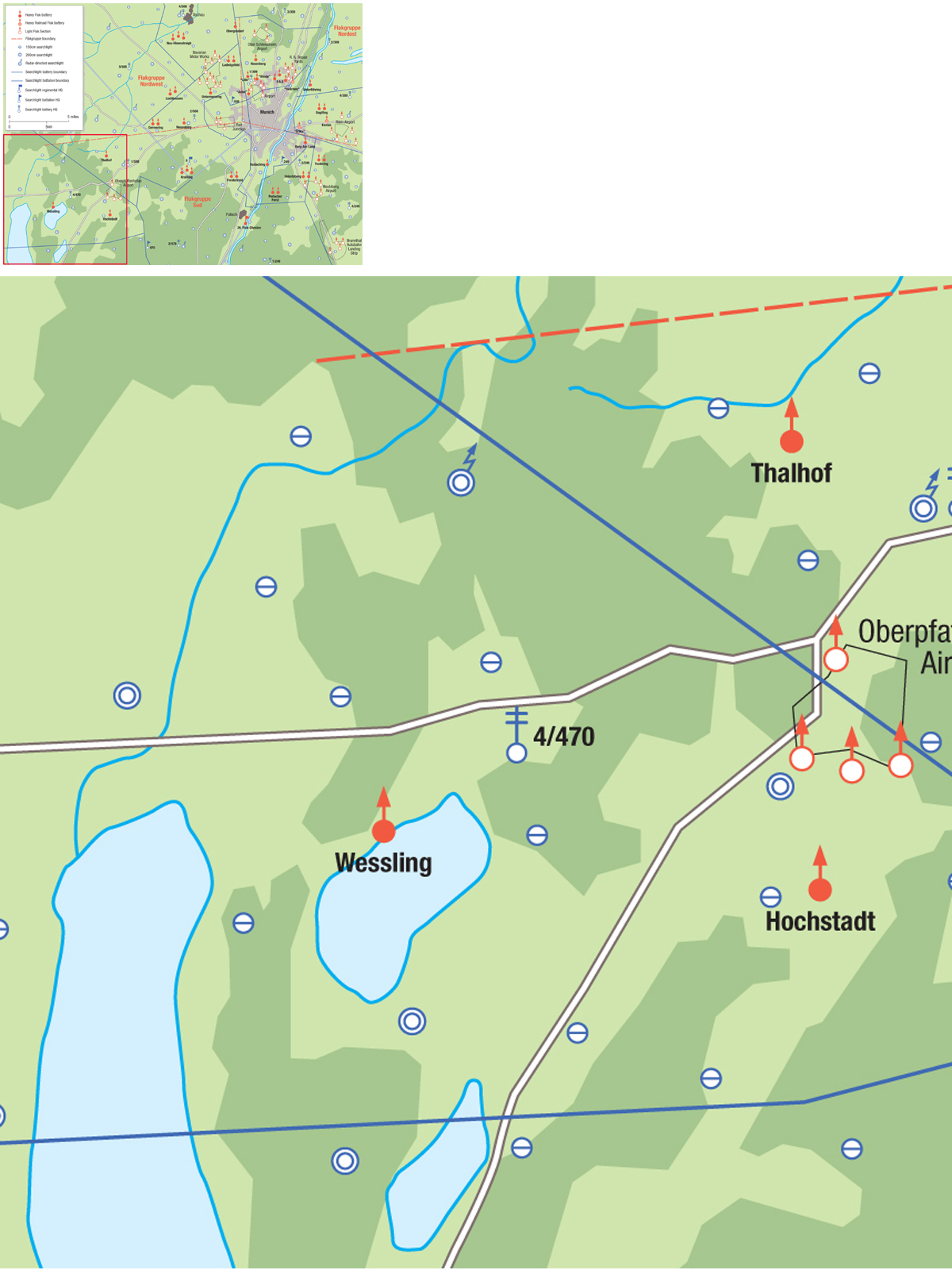
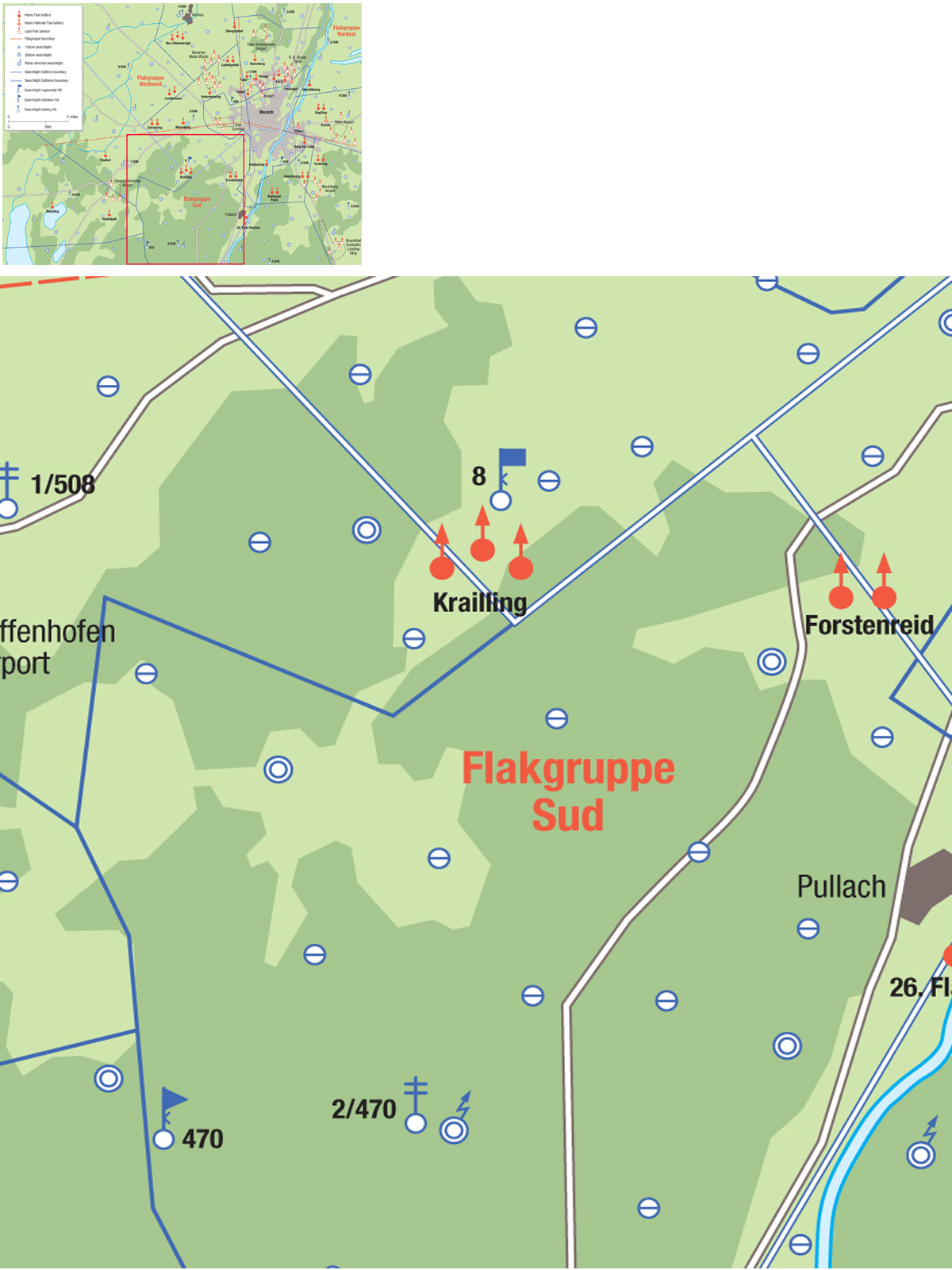
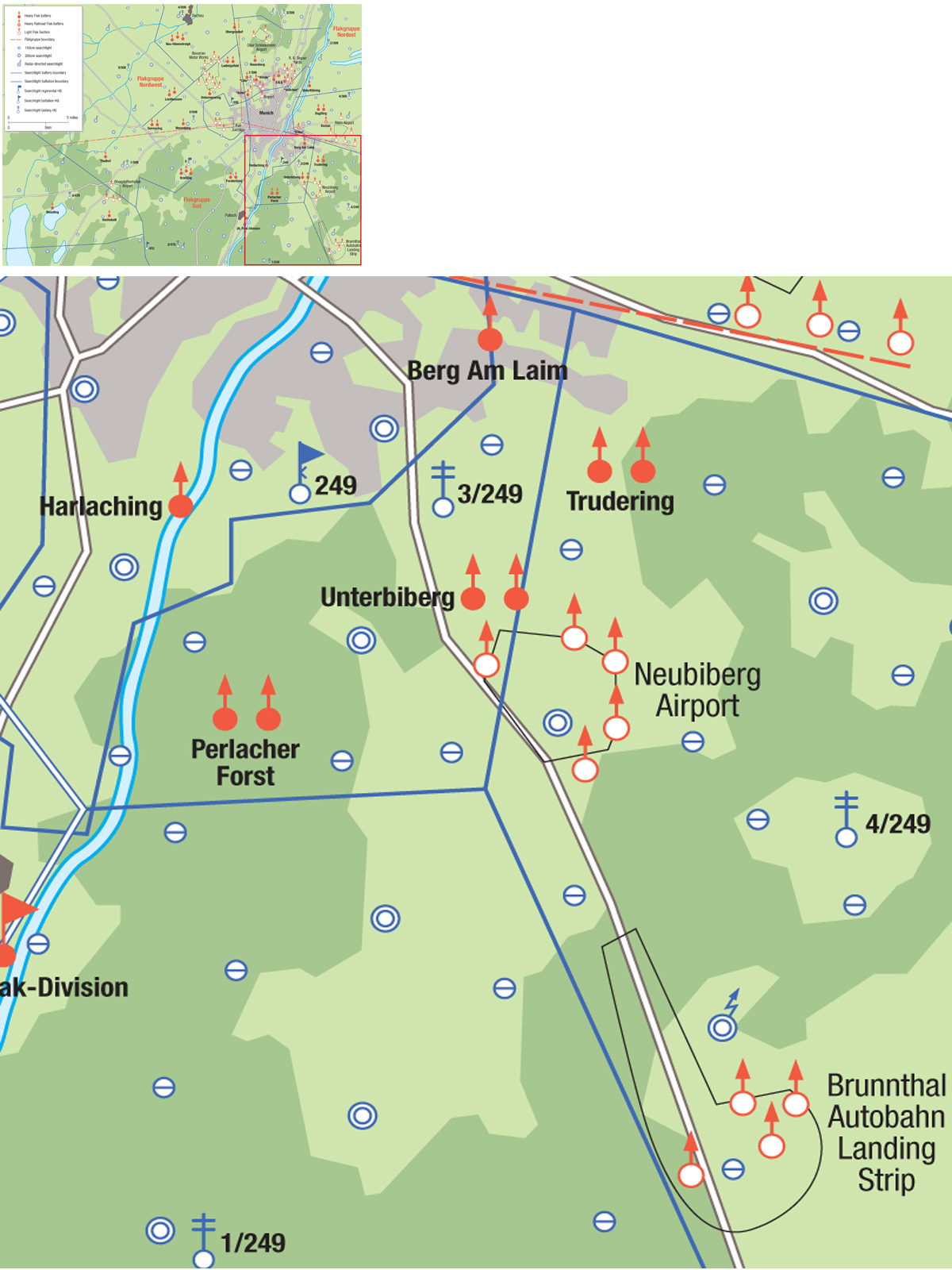
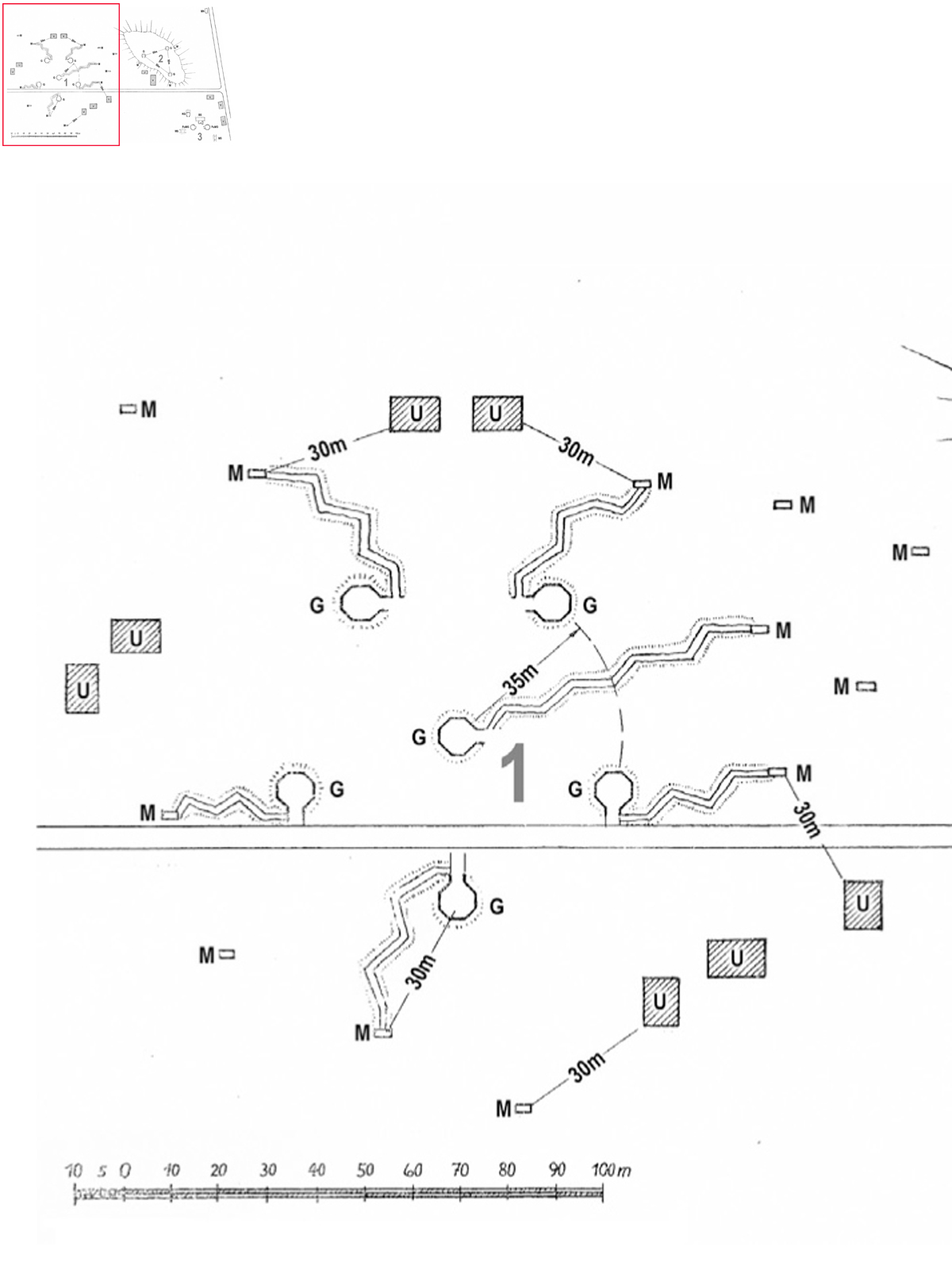
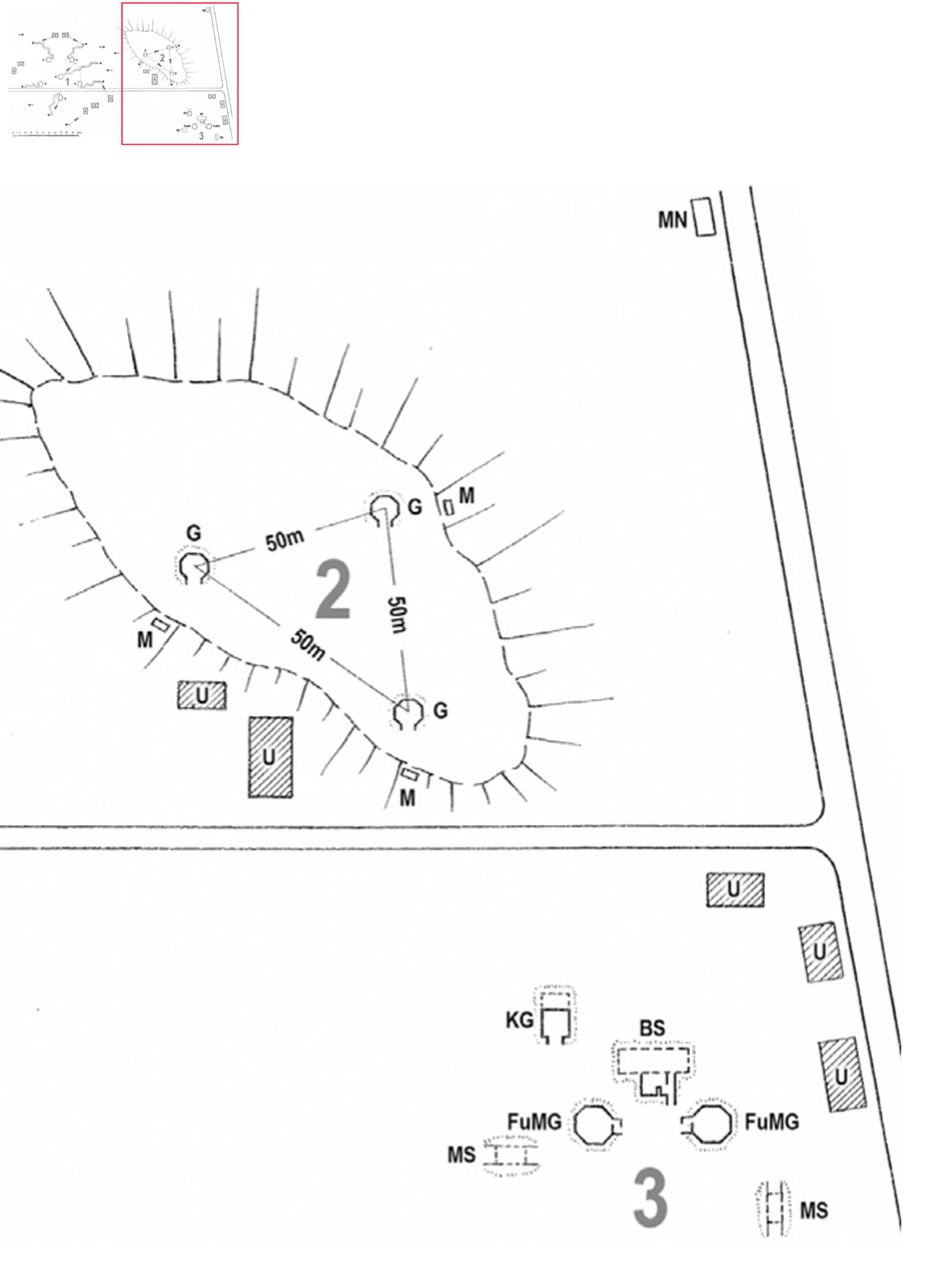
This is the suggested layout for a six-gun heavy Flak battery from the October 1943 manual. The heavy gun battery (1) includes six gun-pits (G: Gefechtsstand) along with associated underground ammunition shelters (M: Munitionsunterschlupf) connected by trenches, as well as underground crew shelters (U: Unterkunft). On a hill to the right is a three-gun light flak section (2) to provide protection for the main battery; it has a similar arrangement of munition and crew shelters. The battery fire control centre (3) includes the command post (BS: Befehlsstand); two radars (FuMG: Funkmeßgerät), and gun director (KG: Kommandogerät) and two dugouts for associated power generator trailers (MS: Maschinensatzschuppen). The site measures approximately 320m wide (1,000ft) by 120m (400ft) deep.
Even after the advent of radars, sound detectors were never completely abandoned, because of the shortage of radar equipment. Sound detectors were revived after the summer of 1943 when the RAF began introducing effective anti-radar tactics using “Window” jamming strips. So there were still 5,560 sound detectors in service in 1944.
Reich defense forces had large numbers of light Flak guns in the 20mm and 37mm range, but they played a minor role in defending the Reich against air attack in 1941–44 since the bombers usually attacked from altitudes outside their range. Light Flak remained useful in tactical air defense, and so surplus batteries were redeployed outside Germany. There was a short revival of light Flak from mid-1944 to 1945 due to the increasing number of Allied fighters engaging in strafing missions, and this issue will be discussed in more detail below.
Although Luftwaffe Flak doctrine stressed the need for mobility, industrial shortcuts through the war forced the heavy Flak into static deployments. The cruciform platform and associated transport caissons that were fitted to pre-war Flak guns were expensive to manufacture, and were usually idle at most Flak sites for years at a time. As a result, by 1942, the Flak industry dropped the cruciform mounts for home defense Flak guns in favour of a simple pedestal mount (Sockellafette) especially for the heavy 105mm and 128mm guns and Göring formally ordered this switch in June 1942.
While static gun batteries were more economical, there was still the need for a mobile reserve. Allied bombing campaigns in 1943–44 often switched their focus from one city or region to another, and so some static Flak units were overwhelmed, while at the same time neighbouring units were entirely idle. This issue had been recognized even before the war, and led to the creation of the first ten railway Flak batteries (Eisenbahn-Flak). The growing need for this mobile reserve force increased after the June 1942 decision to deploy most of the Flak in static positions, so plans were drawn up to deploy 100 railroad batteries by 1943. It was originally hoped to base this on heavier calibre 105mm and 128mm guns, but in the end, all three common heavy Flak guns were used, the 88mm, 105mm and 128mm. About 50 railroad batteries were deployed by 1942, and 100 by 1943. Priority for railroad batteries was given to industrial zones, and secondly to major railway marshalling yards.
Heavy Flak guns deployed in the air defense of the Reich were based mainly in static entrenchments. The design of the Flak emplacements was overseen by the Fortification Unit of the Inspectorate for Flak Artillery (Insp. der Flakartillerie-Abteilung Befestigung). Luftwaffe Flak tactics recognized three principal modes of Flak emplacement: basic (einfache), reinforced (verstärkte) and enhanced (erweitere). The basic emplacement (einfache Feldstellung) offered an elementary form of temporary protection that could be constructed by the battery’s own crews using simple and readily available material. Through the late 1930s, the Luftwaffe manuals recommended a simple earth berm, but by 1940, more elaborate structures were recommended. One 1940 option suggested a parapet around the gun consisting of two parallel walls of wood planking with the space between filled with earth or gravel. The 1943 manual suggested simpler construction using a single wooden plank wall with earth packed against the outside. Flak units seldom used camouflage nets as they interfered with gun readiness and there was little concern that homeland Flak batteries would be targeted.
The reinforced emplacement (verstärkte Feldstellung) used more robust construction material and had a larger and more complex layout. This type of emplacement had concrete over the crew quarters and munitions lockers and so was intended to offer better protection against air attack. Although log construction was the most common configuration, this type of emplacement could also substitute concrete or brick construction when available. These type of emplacements were often built with the assistance of specialized Luftwaffe construction units.
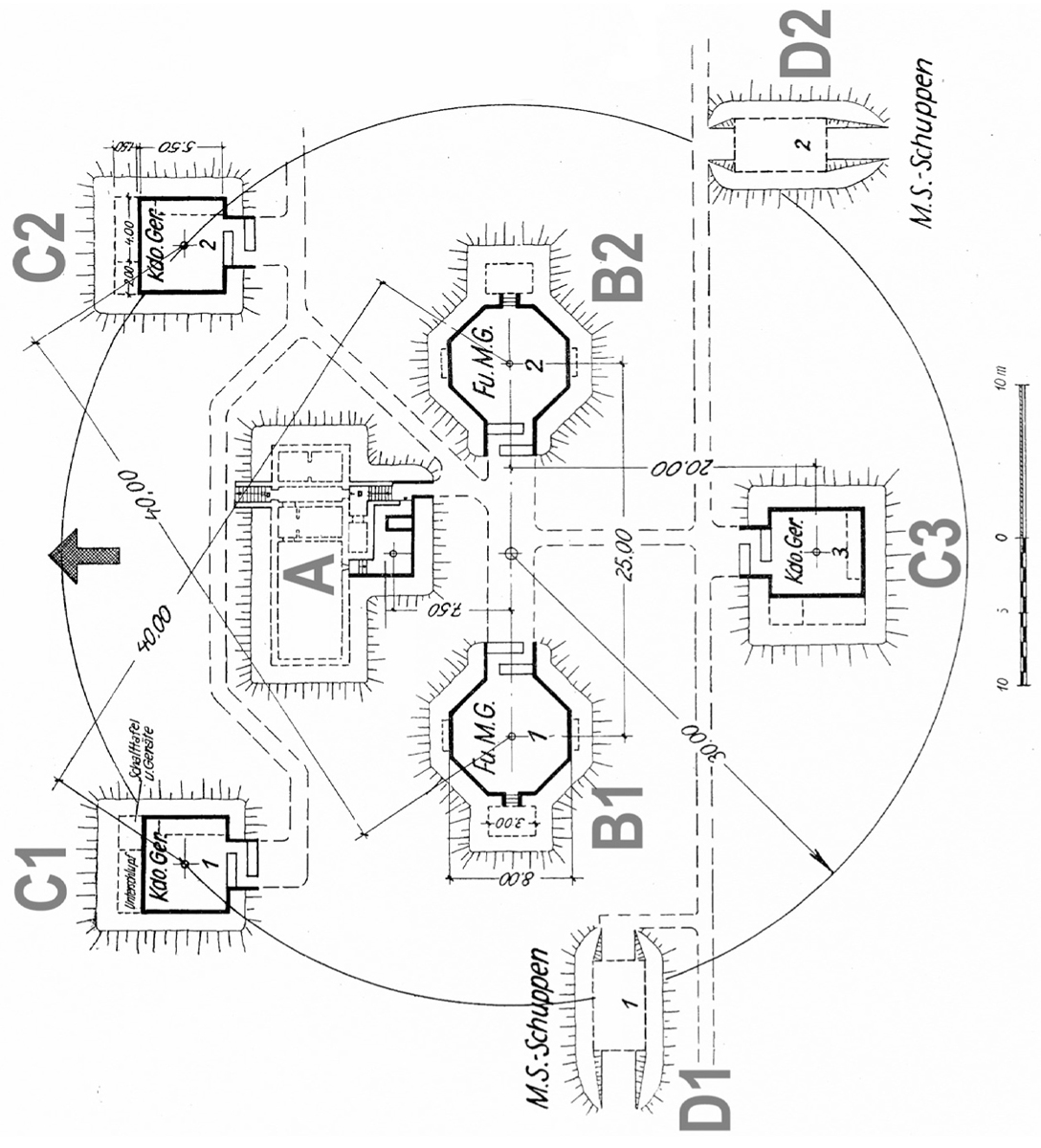
This is the suggested layout for a Grossbatterie command centre (Befehlsstelle) from the October 1943 Luftwaffe manual. This particular configuration is for a three-gun battery; a two-gun battery would have only two Kdo.Ger. 40 and a one-gun battery only one. The site is approximately 60m (200ft) in diameter. The command post A (Befelsstand) is in the centre of the position and the arrow points in the direction of main command post. The two radar fire-direction posts (B1 and B2) are located behind the command post. Around the periphery of the site are the three Kommandogerät 40 gun directors, one dedicated to each battery (C1-C3). There are also two entrenchments (D1, D2) for associated power generator trailers (Maschinensatz Schuppen or MS).
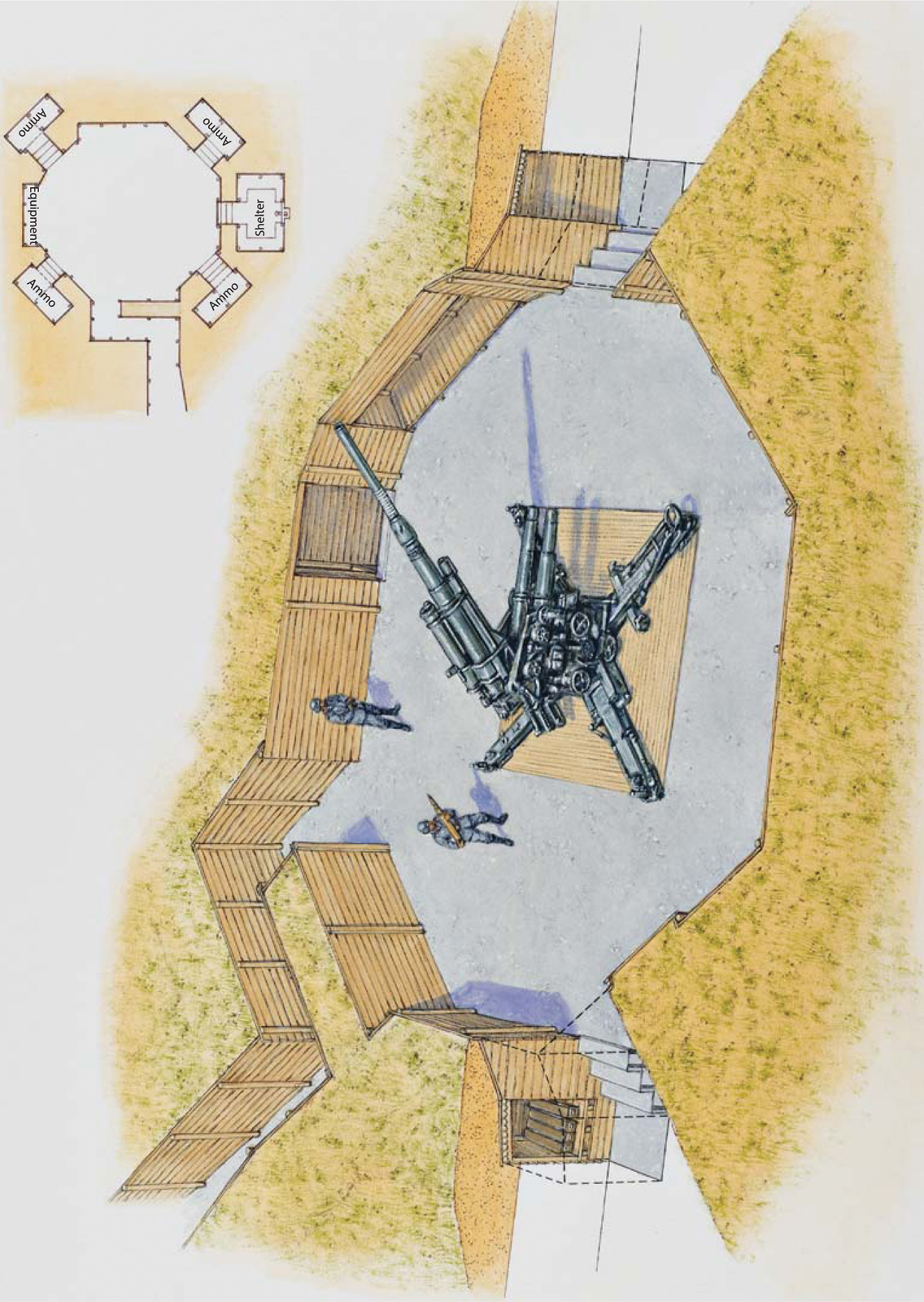
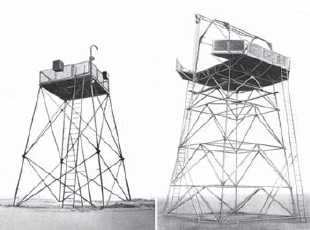
In 1941–42, the Luftwaffe deployed elevated platforms (Flakhochstand) to provide clear fields of fire for light Flak guns in forested regions or in congested areas such as airfields. This shows two of the standard designs, the light 8m (26ft) stand for 20mm guns (left) and the heavy stand 11m (36ft) stand for quadruple 20mm gun, 37mm gun, or the 150cm searchlight (right). The heavy stand here is shown with a special crane fitted that was used to lift the gun into place. A shortage of these in 1944 led many light Flak units in Germany to construct their own out of timber. (NARA)
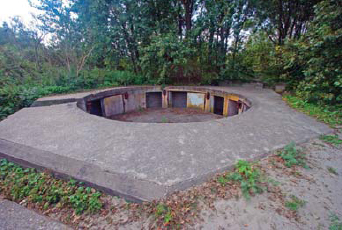
The Luftwaffe and Kriegsmarine Flak batteries along the Dutch coast were often deployed in L4 and L5 reinforced concrete gun-pits with ammunition lockers protected by steel doors. This is a surviving example in the Hook of Holland area. (Author)
The enhanced emplacement (erweitere Feldstellung) was designed to make the position weather-proof and more resistant to battle damage. The floors of the gun-pits were to be covered with concrete, for example, and in general, more concrete or brick was used in construction. This level of protection was also intended to offer better protection against the blast and shrapnel from nearby heavy bombs, although the site itself was not resistant to direct hits. The enhanced emplacement was considered the preferred level of protection for Flak units in homeland defense. In some cases, units that had recently moved would be protected at the lower field standards, but that was only a temporary expedient. The construction of the more elaborate concrete Flak bunkers typical of the Atlantikwall was generally avoided for strategic air defense in Germany for both economic and tactical reasons as mentioned earlier.
The basic element of each battery position was the G-Stand (Gefechtsstand, or “battle post”) for each Flak gun in the battery. A typical G-Stand had outer walls consisting of an earthen berm with the earth provided by excavating the emplacement to a depth of about a metre (3 feet). When viewed from above, the G-Stand had an octagonal shape with one or two sides serving as entrance to the pit, four sides containing ammunition lockers, one side containing a small emergency shelter for the crew, and another containing a locker for the gun’s associated sights and equipment. The small crew shelter within the G-Stand was only intended to provide temporary shelter for the crew when the gun was in operation. Usually, crew quarters were provided in nearby barracks or in an underground shelter (Unterkunft). Other major elements of the battery such as the command posts had emplacements similar in construction to the gun-pits. Likewise, searchlight batteries used similar fortification techniques.
Heavy Flak batteries had a large footprint on the ground since the gun pits had to be spaced apart to prevent damage from the gun blast to neighbouring guns and fire-control equipment. The configuration of the heavy Flak battery position evolved during the course of the war, with the arrival of the enlarged batteries. Although the configuration of the gun-pits remained much the same, the layout of the battery’s command elements changed once new fire controls, especially radars, became available.
 |
REINFORCED 88MM FLAK G-STAND, 1943 PATTERN |
This shows the recommended layout for a reinforced gun-pit (verstärkte Gefechtsstand) based on the October 1943 Luftwaffe manual, Flakartillerie: Stellungs- und Befestigungsbau der Flakartillerie: L.Dv.400/11a. The gun-pit has the standard octagonal shape, with four walls containing munitions lockers, one wall containing an emergency shelter for the crew, and one wall containing a niche for the gun tools and equipment. Reinforced positions such as this would have wood, concrete or gravel for the floor, while the sides would usually be made of timber. The lockers would have a concrete roof for better protection. This gun-pit is 7.5m (25ft) wide and 1.8m (6ft) deep. The next step up in gun-pits was the enhanced field emplacement (erweitere Feldstellung) which would substitute more cement and brick instead of wood to make the position more weather-proof.
In the early war years from 1939 to 1941, a typical heavy Flak battery was deployed in a circle around its Command Post II (Befehlsstelle II) with the gun-pits about 70–80m (230–62ft) from the centre. Command Post II consisted of a subordinate command section operating a Kommandohilfsgerät 35 (Kdo.Hi.G.35) auxiliary gun director and a small optical range-finder as a back-up for the main gun director. This post also contained electrical junction boxes (Verteilerkasten) that fed into the gun pits; one connected to the battery’s mobile electrical generators for power, and the other ran to the main command post. The battery’s Command Post I (Befehlsstelle I) was usually located at least 100m (328ft) away from the gun-pits to avoid jostling the delicate fire controls by gun blast. The central element of this post was the Kommandogerät 40 gun director (Kdo G. 40), which provided firing data to the guns. The Kommandogerät 40 received early warning data electrically from early-warning radar posts, and had an integral optical range-finder to collect azimuth and angular height data by visual tracking either as the primary source for the guns, or as an adjunct to the radar data in later years as more radars became available. The device produced ballistic solutions and fuze data for the individual guns in the battery and passed this data electrically to the gun pits by cable connections. In contrast to field emplacements, the cabling in static heavy gun batteries was usually buried. One or more generators were positioned near the command post to provide electrical power both to the guns and the command post. In some cases the battery’s communications section (Funkstelle) was located separately from the command post, but in static positions, it was often located in or near the command post.
The battery command posts increased in complexity as the war went on, and due to the increasing number of expensive electronic devices, the command posts went from simple, cheaply constructed huts to more elaborate shelters of brick or concrete. With the advent of radar, in 1942 the battery command posts began to receive the new Flakumwertegerät Malsi 35. This was a data converter system that would receive target data from the radars, which could then be displayed in the command post on its semi-automated plotting tables. The command post usually received two Malsi tables, and this required the addition of a large room in each command post.
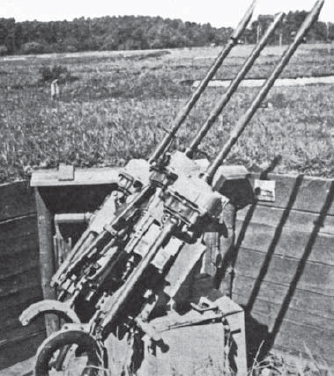
The change in USAAF tactics after February 1944 saw the growing use of escort fighters to strafe Luftwaffe airfields. To discourage low-altitude attacks, the long-neglected light Flak units of the homeland defense force were shifted to air bases to provide protection. An expedient solution to the strafing attacks was the FlaSL 151 (Fliegerabwehr-Sockellafette mit 3 MG 151), an inexpensive pedestal mount armed with three MG 151 aircraft cannon. This particular example was deployed near an airfield in the Munich area by the 26. Flak-Division in 1945. (MHI)
The new Grossbatterie tactics introduced in 1942 led to a reconfiguration of Flak batteries, with multiple batteries sharing an amalgamated Flak operations centre instead of individual battery command posts. The old Befehlsstelle II disappeared, and so in the case of a six-gun battery, there would be one gun pit in the centre and the remaining gun pits in a star pattern around it. The fire directors and new fire-control radars were concentrated at the new operations centre. This new centralized command post would contain one Kdo G. 40 gun director per battery, so there were three at the command post in the case of a three-battery Grossbatterie. The most important addition to the command post was a pair of fire direction radars. These were typically the Funkmessgerät. 39 (FuMG. 39) or FuMG. 41. One fire control radar was used to control the gun-directors and to maintain track of the targeted enemy bomber formation, while the other radar was kept free to search for other formations, or to conduct supplementary scans of the targeted formation to select the most lucrative targets.
The new operations centre shelter continued to expand due to the sophistication of the data flowing into it from the early-warning network and the increasing number of communication devices and plotting displays. By 1943, the typical operations centre had a switchboard room for communications, a cable room for junctions for its own sensors and remote data sources, a map room, a data room for remote data panels and a plotting room containing two Malsi 35 plotting tables. The Malsi plotting tables took on a new importance after the RAF introduced radar jamming tactics such as Window in the summer of 1943. The Malsi could accept data from neighbouring batteries, neighbouring radars, or the command post’s own optical directors, so that in the event of Allied radar jamming, the Grossbatterie could still engage its targets.
Although the Flak divisions continued to deploy light Flak batteries through the war years, they had little value in homeland defense due to the high operating altitudes of British and American bombers. This began to change after January 1944 when the US Eighth Air Force launched more aggressive fighter tactics and began to encourage low-altitude sweeps against German airfields. Suddenly, there was an immediate need for light Flak. The situation grew progressively worse through 1944 as the Allied armies advanced into Germany and the number of Allied fighter planes roaming in German air space increased. The focus of early USAAF fighter attacks in early 1944 were German airfields as part of Operation Pointblank, the mission to smash the German fighter force prior to the D-Day landings. As a result, the Luftwaffe began to transfer idle light Flak units to participate in airfield defense. This is very evident on the map of the Munich area shown on page 15 where most of the light Flak sections are deployed near airfields or communication hubs. Light Flak units used static emplacements essentially similar to the heavy Flak batteries, except that the fire control posts tended to be less elaborate since heavy Flak had priority for radar.
The increasing number of light Flak batteries positioned around German airfield in early 1944 led to evolving USAAF fighter tactics, especially the use of low-level manoeuvres to minimize exposure to light Flak. These low-level tactics encouraged the Luftwaffe light Flak units to deploy some of their batteries on elevated Flak stands (Flakhochstanden) which provided better fields of fire, especially in situations where there were obstacles such as buildings or wooded areas. The Luftwaffe had already developed a family of prefabricated modular steel platforms early in the war. There were two light Flak stands for the 20mm guns in 5m (15ft) and 8m (28ft) configurations, as well as a heavy Flak stand 11m (36ft) high which could be used for the quadruple 20mm gun, 37mm gun, or the 150cm searchlight. Although these could be disassembled and moved, sudden demand in mid-1944 meant that they were in short supply. As a result, many light Flak batteries began constructing wooden platforms patterned on the steel version using available resources. Alternately, light Flak guns were placed on the roofs of high buildings.
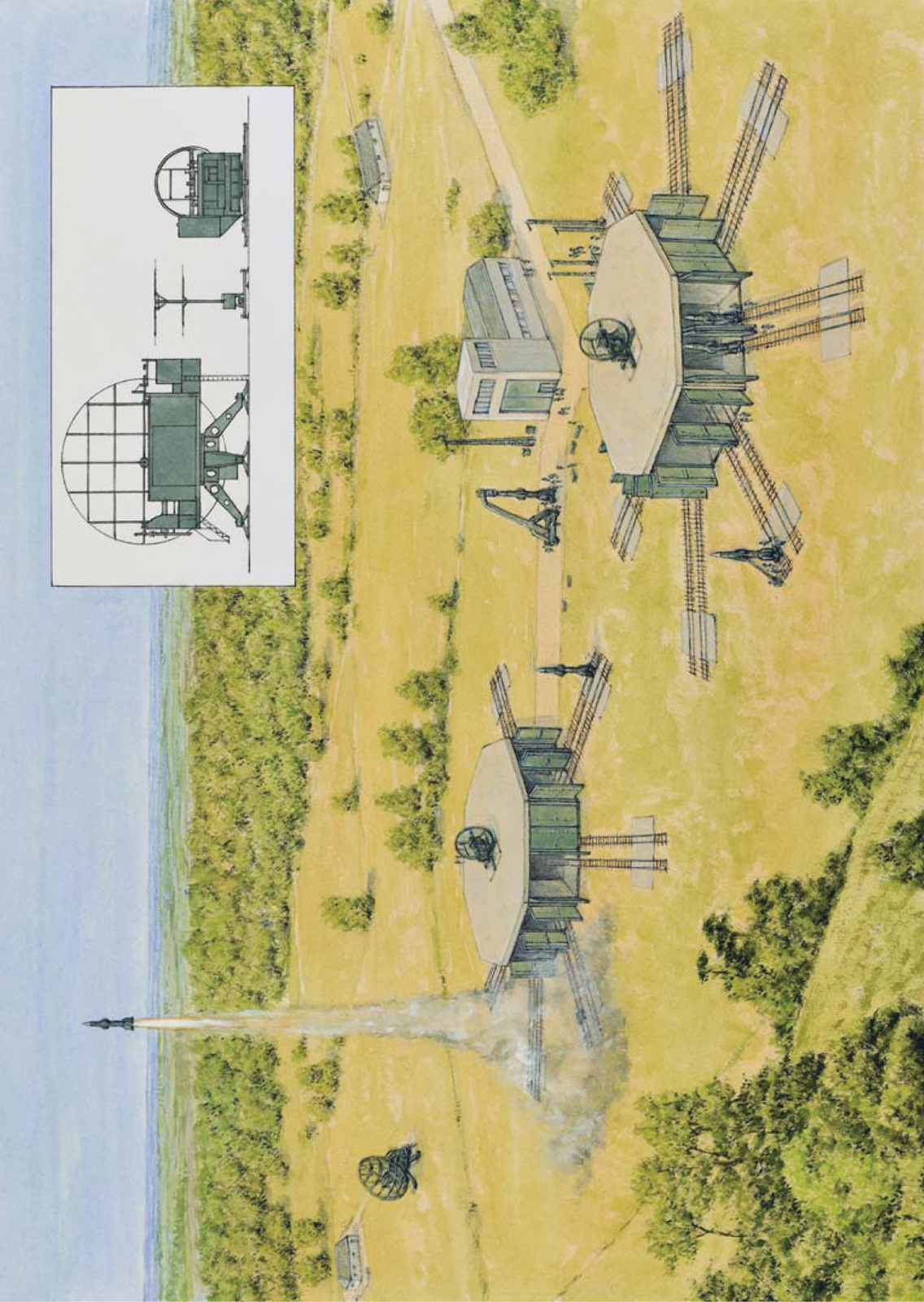
The steady drone of RAF aircraft along the “bomber Autobahn” over the Netherlands and into Germany encouraged the Luftwaffe to create its densest air defense zone in this sector. Kammhuber’s main command post, for example, was located at Zeist in the Netherlands. However, the Luftwaffe’s night-fighter force did not want to become entangled with the dense concentrations of Flak batteries for fear of “friendly fire” incidents, so this area did not receive high priority for Luftwaffe heavy Flak batteries in 1940–43. Nevertheless, the opportunity to take shots at British bombers both as they approached and departed Germany was too good to ignore. In 1942, a Flak belt was established in the Low Countries along the north coast where it was too far forward to interfere with the Kammhuber Line. This had been a traditional role for the Kriegsmarine during World War I, when a naval Flak group had been deployed with the Marinekorps Flandern along the North Sea coast. The new program became wrapped up in the Atlantikwall effort, since the Marineflak could serve a dual role in anti-invasion defense against surface targets, as well as in air defense against the RAF. Eventually some 23 Marineflak heavy batteries were deployed in the Netherlands, from the Hook of Holland to the German coast.2
Since these Marineflak batteries were positioned along the coast, they were deployed in heavily fortified bunkers like other elements of the Atlantikwall. These fortified positions were laid out much the same as Luftwaffe heavy Flak batteries, but the emplacements were constructed of steel-reinforced concrete instead of earth berms and timber. The associated crew and ammunition shelters were fully protected bunkers, able to withstand direct bomb hits or naval shelling. Two of the more common gun bunkers used by the Marineflak in the Netherlands were the Fl.243 Schwere Flakstand and the later Luftwaffe L 401 Geschützstand für 8,8 oder 10,5cm Flak. These had the gun-pit located on the top of the bunker, and a fully protected shelter for the crew underneath. Some batteries had their guns in a simple concrete kettle gun-pit, such as the L4 and L5 designs, with the crew shelter located separately. A portion of the Marineflak batteries had their guns protected in fully-armored steel turrets. The heavy Marineflak batteries in the Netherlands were most often equipped with the Rheinmetall-Borsig 105mm SK C/32.
 |
WASSERFALL FLAK MISSILE BATTERY SITE, PROPOSAL B |
The shape of things to come. The declining effectiveness of conventional Flak led the Luftwaffe to design first-generation Flak missiles, of which the Wasserfall C2 (“waterfall”) was the most advanced. The first two batteries were expected to be operational in late 1945, with about 300 more by the end of 1946. In April 1943, three configurations of battery emplacement were proposed: from a simple site with unprotected hangers (Entwurf A [“Proposal A”]), a partially fortified site as seen here (Entwurf B) and a fully fortified site with the missile stored in a single bunker (Entwurf C). The intention was to store 80 missiles per battery site, with a total of eight launch pads, and the capability to fire about 35 missiles against a single bomber formation. The Entwurf B Batteriestellung shown here had two octagonal concrete launch bunkers, each containing 16 missiles on their wheeled launch pads; each of the eight launch cells would wheel out one missile at a time, while the second missile in each cell was being prepared for the next launch sequence. The early versions of the missile employed the Burgund commandguidance system, but the ultimate fire-control shown here is the radar command-guided Rheinland A system. The Mannheim-Rüse radar served as the battery’s search and track system. The two bunkers were each fitted with a Rheingold fire-control radar working in conjunction with a Kehlheim command station (not visible here). Besides the two launch bunkers, the battery site also had a command post with an attached maintenance/preparation hangar. Although Wasserfall never entered production, it was a stepping stone to the first Soviet surface-to-air missile (SAM) in 1950, the S-25 Berkut (NATO: SA-1 Guild).
The Luftwaffe had an extensive presence in the Atlantikwall program, primarily involved in the deployment of an array of early warning posts. These included numerous long-range early radars including Mammut and Freya radars, as well as other types of early warning sensors and electronic signals interception posts that were used to alert Luftwaffe fighter and Flak units in Germany of impending RAF and USAAF bomber raids. As in the case of the Marineflak, the proximity of these sites to the coast led to the decision that they would be fortified with bunker-type crew shelters.
Germany’s heavy investment in Flak artillery failed to defeat Allied heavy bombers. The Flak force consumed between a quarter and a third of Wehrmacht ordnance and ammunition production; the associated radars and communications equipment consumed half the military electronics production. The failure was not so much the Flak guns, which were the best in the world, but the leadership in the senior ranks of the Luftwaffe who failed to appreciate the central importance of modern electronics to air defense. Germany was slow to field an integrated air defense network, and failed to keep pace with Britain in electronic warfare. The Flak batteries became increasingly blind after the summer of 1943 as the RAF employed ever more sophisticated electronic warfare tactics. The USAAF added to the problem, backed as it was by America’s prodigious electronics industry, which flooded the skies with new radars, jammers and other electronic warfare aids. Flak might have been partly redeemed by the introduction of a radio-frequency proximity fuze like the American VT fuze, but once again, poor allotment of resources in 1942–43 delayed the development of this critical technology. Germany turned instead to even more exotic weapons, such as radar-guided anti-aircraft missiles, but this was another case of overly ambitious schemes started much too late. The arguments about the effectiveness of Flak in 1940–45 are too complex to cover in detail in this short book.
1 For further details and the Atlantic Wall see: Steven Zaloga, The Atlantic Wall (1): France (Osprey Fortress 63, 2007) and The Atlantic Wall (2): Belgium, the Netherlands, Denmark, and Norway (Osprey Fortress 89, 2009).
2 For further details of these Marineflak batteries see: Steven Zaloga, The Atlantic Wall (2): Belgium, the Netherlands, Denmark, and Norway (Osprey Fortress 89, 2009).